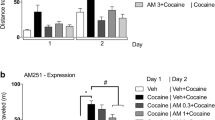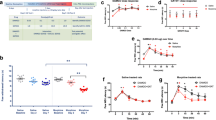Abstract
Background
Previous studies show that some non-CB1/non-CB2 effects of cannabinoids are mediated through G protein coupled receptor 55 (GPR55). As this receptor is activated by some of cannabinoid receptor ligands and is involved in the modulation of pain, it was hypothesized that this receptor may also interact with opioids. This study examined the effect of atypical cannabinoid O-1602 as a GPR55 agonist on morphine-induced conditioned place preference (CPP) and physical dependence.
Methods
We used a biased CPP model to evaluate the effect of O-1602 (0.2, 1 and 5 mg/kg, intraperitoneal; ip) on the acquisition and expression of morphine-induced CPP in male mice. The locomotor activities of mice were also recorded. Moreover, repeated administration of morphine (50, 50 and 75 mg/kg/day) for three days, induced physical dependence. The withdrawal signs such as jumps and diarrhea were precipitated by administration of naloxone (5 mg/kg, ip). The effect of O-1602 on the development of morphine physical dependence was assessed by injection of O-1602 (0.2, 1 and 5 mg/kg) before morphine administrations.
Results
Morphine (40 mg/kg, subcutaneous; sc), but not O-1602 (5 mg/kg) elicited significant preference in the post-conditioning phase. O-1602 at the doses of 0.2 and 1 mg/kg, but not 5 mg/kg reduced acquisition of morphine CPP with an increase in locomotor activity at the dose of 5 mg/kg. O-1602 at the doses of 0.2, 1 and 5 mg/kg also reduced expression of morphine CPP with an increase in locomotor activity at the dose of 5 mg/kg. O-1602 had a significant inhibitory effect on development of morphine-induced physical dependence at the dose of 5 mg/kg by decreasing jumps and diarrhea during withdrawal syndrome.
Conclusions
The present results indicate that O-1602 decreased acquisition and expression of morphine CPP and inhibited development of morphine-induced physical dependence.
Similar content being viewed by others
References
Fields HL. The doctor’s dilemma: opiate analgesics and chronic pain. Neuron 2011;69:591–4.
Rezahosseini O, Roohbakhsh A, Tavakolian V, Assar S. Drug abuse among university students of Rafsanjan, Iran. Iran J Psychiatry Behav Sci 2014;8:81–5.
Hamidi GA, Jafari-Sabet M, Abed A, Mesdaghinia A, Mahlooji M, Banafshe HR. Gabapentin enhances anti-nociceptive effects of morphine on heat, cold, and mechanical hyperalgesia in a rat model of neuropathic pain. Iran J Basic Med Sci 2014;17:753–9.
Liu B, Song S, Jones PM, Persaud SJ. GPR55: from orphan to metabolic regulator. Pharmacol Ther 2015;145:35–42.
Henstridge CM. Off-target cannabinoid effects mediated by GPR55. Pharmacology 2012;89:179–87.
Ryberg E, Larsson N, Sjogren S, Hjorth S, Hermansson NO, Leonova J, et al. The orphan receptor GPR55 is a novel cannabinoid receptor. Br J Pharmacol 2007;152:1092–101.
Lauckner JE, Jensen JB, Chen HY, Lu HC, Hille B, Mackie K. GPR55 is a cannabinoid receptor that increases intracellular calcium and inhibits M current. Proc Natl Acad Sci U S A 2008;105:2699–704.
Oka S, Nakajima K, Yamashita A, Kishimoto S, Sugiura T. Identification of GPR55 as a lysophosphatidylinositol receptor. Biochem Biophys Res Commun 2007;362:928–34.
Sawzdargo M, Nguyen T, Lee DK, Lynch KR, Cheng R, Heng HH, et al. Identification and cloning of three novel human G protein-coupled receptor genes GPR52, PsiGPR53 and GPR55: GPR55 is extensively expressed in human brain. Brain Res Mol Brain Res 1999;64:193–8.
Henstridge CM, Balenga NA, Kargl J, Andradas C, Brown AJ, Irving A, et al. Minireview: recent developments in the physiology and pathology of the lysophosphatidylinositol-sensitive receptor GPR55. Mol Endocrinol 2011;25: 1835–48.
Deliu E, Sperow M, Console-Bram L, Carter RL, Tilley DG, Kalamarides DJ, et al. The lysophosphatidylinositol receptor GPR55 modulates pain perception in the periaqueductal gray. Mol Pharmacol 2015;88:265–72.
Wu CS, Chen H, Sun H, Zhu J, Jew CP, Wager-Miller J, et al. GPR55, a G-protein coupled receptor for lysophosphatidylinositol, plays a role in motor coordination. PLOS ONE 2013;8:e60314.
Rahimi A, Hajizadeh Moghaddam A, Roohbakhsh A. Central administration of GPR55 receptor agonist and antagonist modulates anxiety-related behaviors in rats. Fundam Clin Pharmacol 2015;29:185–90.
Robledo P, Berrendero F, Ozaita A, Maldonado R. Advances in the field of cannabinoid — opioid cross-talk. Addict Biol 2008;13:213–24.
Imenshahidi M, Qaredashi R, Hashemzaei M, Hosseinzadeh H. Inhibitory effect of Berberis vulgaris aqueous extract on acquisition and reinstatement effects of morphine in conditioned place preferences (CPP) in mice. Jundishapur J Nat Pharm Prod 2014;9:e16145.
Rezayof A, Sardari M, Zarrindast MR, Nayer-Nouri T. Functional interaction between morphine and central amygdala cannabinoid CB1 receptors in the acquisition and expression of conditioned place preference. Behav Brain Res 2011;220:1–8.
Niu H, Zheng Y, Huma T, Rizak JD, Li L, Wang G, et al. Lesion of olfactory epithelium attenuates expression of morphine-induced behavioral sensitization and reinstatement of drug-primed conditioned place preference in mice. Pharmacol Biochem Behav 2013;103:526–34.
Breen C, Brownjohn PW, Ashton JC. The atypical cannabinoid O-1602 increases hind paw sensitisation in the chronic constriction injury model of neuropathic pain. Neurosci Lett 2012;508:119–22.
Schuelert N, McDougall JJ. The abnormal cannabidiol analogue O-1602 reduces nociception in a rat model of acute arthritis via the putative cannabinoid receptor GPR55. Neurosci Lett 2011;500:72–6.
Zarrindast MR, Mohajeri S. Influence of ATP-dependent K+ channels on nicotine-induced inhibition of withdrawal in morphine-dependent mice. Eur J Pharmacol 2006;552:90–8.
Karimi S, Azizi P, Shamsizadeh A, Haghparast A. Role of intra-accumbal cannabinoid CB1 receptors in the potentiation, acquisition and expression of morphine-induced conditioned place preference. Behav Brain Res 2013;247:125–31.
Tzschentke TM. Measuring reward with the conditioned place preference paradigm: a comprehensive review of drug effects, recent progress and new issues. Prog Neurobiol 1998;56:613–72.
Li K, Fichna J, Schicho R, Saur D, Bashashati M, Mackie K, et al. A role for O-1602 and G protein-coupled receptor GPR55 in the control of colonic motility in mice. Neuropharmacology 2013;71:255–63.
Waldeck-Weiermair M, Zoratti C, Osibow K, Balenga N, Goessnitzer E, Waldhoer M, et al. Integrin clustering enables anandamide-induced Ca2+ signaling in endothelial cells via GPR55 by protection against CBl-receptor-triggered repression. J Cell Sci 2008;121:1704–17.
Chaperon F, Soubrie P, Puech AJ, Thiebot MH. Involvement of central cannabinoid (CB1) receptors in the establishment of place conditioning in rats. Psychopharmacology (Berl) 1998;135:324–32.
McHugh D, Hu SS, Rimmerman N, Juknat A, Vogel Z, Walker JM, et al. N-arachidonoyl glycine, an abundant endogenous lipid, potently drives directed cellular migration through GPR18, the putative abnormal cannabidiol receptor. BMC Neurosci 2010;11:44.
Lu VB, Puhl 3rd HL, Ikeda SR. N-Arachidonyl glycine does not activate G protein-coupled receptor 18 signaling via canonical pathways. Mol Pharmacol 2013;83:267–82.
Schicho R, Bashashati M, Bawa M, McHugh D, Saur D, Hu HM, et al. The atypical cannabinoid O-1602 protects against experimental colitis and inhibits neutrophil recruitment. Inflamm Bowel Dis 2011;17:1651–64.
Lichtman AH, Sheikh SM, Loh HH, Martin BR. Opioid and cannabinoid modulation of precipitated withdrawal in delta(9)-tetrahydrocannabinol and morphine-dependent mice. J Pharmacol Exp Ther 2001;298:1007–14.
Ramesh D, Ross GR, Schlosburg JE, Owens RA, Abdullah RA, Kinsey SG, et al. Blockade of endocannabinoid hydrolytic enzymes attenuates precipitated opioid withdrawal symptoms in mice. J Pharmacol Exp Ther 2011;339: 173–85.
Rubino T, Massi P, Vigano D, Fuzio D, Parolaro D. Long-term treatment with SR141716A, the CB1 receptor antagonist, influences morphine withdrawal syndrome. Life Sci 2000;66:2213–9.
Author information
Authors and Affiliations
Corresponding author
Rights and permissions
About this article
Cite this article
Alavi, M.S., Hosseinzadeh, H., Shamsizadeh, A. et al. The effect of O-1602, an atypical cannabinoid, on morphine-induced conditioned place preference and physical dependence. Pharmacol. Rep 68, 592–597 (2016). https://doi.org/10.1016/j.pharep.2015.12.009
Received:
Revised:
Accepted:
Published:
Issue Date:
DOI: https://doi.org/10.1016/j.pharep.2015.12.009




